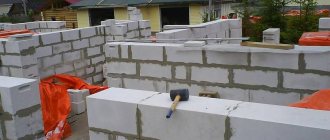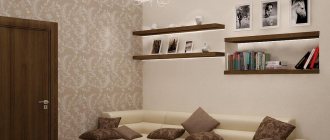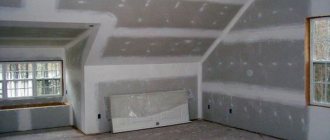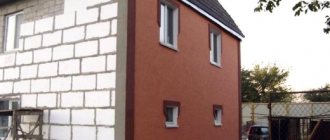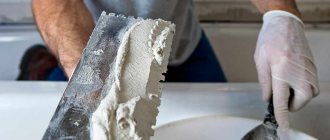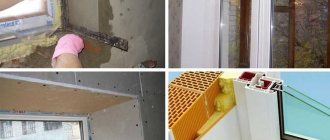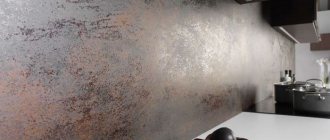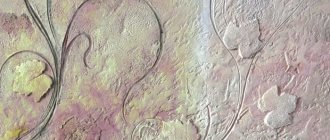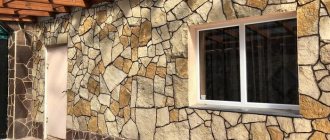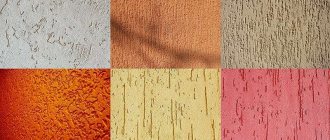The selected plaster for aerated concrete must have optimal parameters and perform protective functions. Simply put, it should protect the walls of the building from destruction and cracks. When applied correctly, long service life and aesthetics are guaranteed. Aerated concrete has excellent thermal insulation and vapor permeability properties due to its porosity. Proper finishing of aerated concrete will allow maintaining these parameters, as well as avoiding the accumulation of moisture and fungus.
In this article we will look at what type of plaster is available at home, how to choose it, the requirements for it, application features and more. Go.
Plaster for finishing aerated concrete: parameters and features. How to choose?
Plastering aerated concrete insulates the masonry surface from waterlogging and minimizes the likelihood of the structure being blown through. Its appearance depends on which side of the house it will be applied from - the inside or outside (facade). There are two main groups: gypsum and cement-sand. Let's consider each type separately.
Gypsum plaster is sensitive to moisture, so it is used for interior work, as well as in rooms with normal humidity levels. But it is worth noting that even in this case, the coating requires protection in the form of special impregnations.
Important details:
- Gypsum plaster has identical vapor permeability indicators as aerated concrete. What does this mean? If excellent conditions are created on the outside of the building for the smooth outflow of vapors, then there will be no problems. If, on the outside of the house, you plan to install materials that have low vapor transmission rates, for example, foam insulation, then this type of plaster is not the best option. In this case, experts recommend giving preference to compositions based on gypsum cement or lime-cement.
- Gypsum compositions are especially valued for their snow-white color. Thanks to this, the preparation work for the final finishing of the house is simplified.
- It is pleasant to work due to its low weight and high elasticity.
- It is a universal material (due to its composition), so it can be applied to any walls - brick, aerated concrete.
- The plaster option is selected based on the quality of the surface. There are basic and finishing. If there are defects on the surface, various potholes, chips, then you need to buy both options for mixtures. The difference between them is the size of the filler. In base mixtures the fractions are larger.
Compared to brickwork, aerated concrete is smoother, so universal types of mixtures are often used for plastering it.
Cement-sand - the name speaks for itself. This is a plaster containing sand and cement. Such plaster for the outside of a house is not very suitable, since the vapor permeability indicator is only 0.09 mg/m*h*Pa, when for aerated concrete blocks this figure is three times higher. Hence, as a consequence, secondary hydration. But if, nevertheless, the choice fell on this option, then experts recommend adhering to certain rules, namely: when using it, it is allowed to apply cement-sand plaster after a couple of months. The second point is that it is advisable to perform exactly the same coating from the inside of the house.
Plastering the house - choice
The choice is based on properties that are determined by the composition of the material. Some of the best options for plastering the outside of a house made of aerated concrete blocks are compositions based on acrylic, silicate or silicone. In other cases, it all depends on financial capabilities. The most expensive option is silicate mixtures. If we are talking about rooms with high humidity, for example, a bathroom, then experts recommend opting for cement varieties of plaster. They are resistant to moisture and have a low coefficient of vapor permeability, which eliminates the ingress of excess liquid.
As for living rooms, gypsum plaster is excellent. Why her? Vapor permeable! Natural humidity in the room is guaranteed. The second significant reason for choosing this particular plaster is the savings in material and ease of application.
Popular brands of plaster for the facade of an aerated concrete house
- Ceresit CT 24 is a mineral dry plaster that is in demand in the finishing materials market. Plastic and easy to apply. The prepared composition must be used within 60 minutes. After complete drying, the surface coated with this mixture will be able to withstand temperatures from minus fifty to plus seventy degrees. According to the manufacturer, this plaster can withstand up to one hundred freezing and thawing cycles without losing its performance qualities. Surface painting is allowed within a week after application of the composition.
- Founded by Startwell T-21 - composed of cement and lime, sold in dry form. Resistant to shrinkage, provides strong adhesion to the base, and is impervious to moisture. The thickness of the applied layer can vary from five to thirty centimeters. The prepared composition must be used within three hours. This plaster can withstand up to fifty freeze cycles. If the application technology is followed, this plaster for the facade of a house made of aerated concrete will last quite a long time.
- Baumit Silicone Top. The material has plasticity, provides strong adhesion, and is characterized by water-repellent qualities. Thanks to the varied palette, you can choose any desired color.
- Weber.pas silikon – ready-made silicone plaster. Available in different types, depending on the grain size. The finished coating is not susceptible to moisture. It is also resistant to dirt accumulation, ultraviolet radiation and temperature fluctuations.
- Baumit SilikatTop is a silicate mixture. From two hundred shades you can always choose the appropriate option. It has high vapor permeability. Before working with this plaster, you should familiarize yourself with the application technology.
- CERESIT ST 77 – acrylic mixture with mineral additives. It is used for cladding aerated concrete, provided there is internal waterproofing and ventilation of the house space.
Facade plaster for aerated concrete is produced by many manufacturers. Quick application and resistance to a number of negative factors make it a universal and popular material for finishing external walls. Due to its features and advantages, finishing the facade of an aerated concrete house with plaster has become widespread in modern construction.
Types of plasters suitable for aerated concrete blocks
Based on the type of use, there are two types of plaster - for external and internal use. The first type of composition plays a protective role; its strength, moisture resistance, and thermal insulation properties must be high. Aerated concrete plaster for interior work is used to decorate the walls of a house, therefore, moisture resistance indicators are not a priority, with the exception of the bathroom.
Popular plasters for aerated concrete
As we noted earlier, facade plaster for aerated concrete according to the type of composition comes in the following types:
- acrylic - used when there is high-quality insulation of walls inside the house. Vapor permeability indicators are at an average level. Most relevant for decorative finishing
- silicate – provides a high-quality moisture-resistant and durable coating. It has a good coefficient of vapor permeability and is resistant to abrasion. The service life is over 25 years. The mixtures are convenient and easy to apply. The downside is the small color palette.
- lime-cement – durable, vapor-permeable. It is possible to play colors, adjust the level of water resistance and elasticity due to special additives.
- silicone plaster at home - provides a strong and durable coating. Even when shrinking it does not crack. Thanks to additives, it is possible to play with color and give the facade an exclusive look.
It is not recommended to use cement-sand compositions for plastering structures, since they do not provide a high-quality coating and also crack.
How to choose the right mixture for aerated concrete
External plastering of a house made of aerated concrete blocks - which is better? Experts recommend giving preference to “breathable” compounds.
Lime-cement is the most affordable and not durable. When lime is added to a cement-sand mixture, its plasticity and vapor permeability improve. A significant disadvantage is that a base layer of at least 0.5 cm is required, which subsequently makes the structure of the building heavier. And this is not a small expense. In addition, after drying, the facade must be painted.
The use of external plaster on a house made of mineral-based aerated concrete blocks makes it possible to obtain a high-quality and reliable layer with excellent vapor permeability. The water-repellent composition perfectly withstands temperature changes and does not hurt your pocket.
Silicate compounds protect the walls of the house from mold. They are self-cleaning types, resistant to temperature changes, have excellent adhesive properties, are flexible and durable.
What material to buy for facade work, comparison of characteristics
Plastering aerated concrete walls outside a room can be done with different special mixtures, each of which has both advantages and minor disadvantages.
Mineral compositions
They are considered the most durable and cheapest among thin-layer types of plasters. They are produced in the form of dry mixtures consisting of cement (binder), crumbs, and additives to reduce water absorption. Mineral compositions are not susceptible to fungi and mold. Their only drawback is the limited number of colors.
Silicate compounds
This is a good option for finishing; the binding element is potassium glass.
Main advantages:
- excellent application on aerated concrete surfaces,
- high vapor permeability,
- good moisture repellency.
A small drawback is the lack of variety of colors, which can be corrected by applying the desired coloring material.
All types of silicate compounds are produced ready for use. Their cost is slightly more than dry mineral analogues.
Silicone compounds
They belong to the best materials that can be used for plastering walls made of aerated blocks; polymers are used in their manufacture.
Main advantages:
- long-term operation,
- good vapor permeability,
- resistance to environmental influences,
- plastic.
The latter protects against cracks.
Silicone plaster is produced in a ready-to-use form and has a huge range of shades.
The only negative is the high price.
Acrylic compounds
Suitable for finishing aerated concrete if additional conditions are met:
- facades must be well ventilated;
- the presence of waterproofing of the walls (from the inside).
These requirements are associated with insufficient vapor permeability of acrylic compositions.
To determine how to plaster gas silicate blocks on the outside, you should carefully study the information about suitable materials and analyze all the pros and cons. Only then make a choice.
Basic requirements for plaster
Aerated concrete is a porous material. The main function of finishing is to prevent moisture from entering the material. It is not recommended to use ordinary plaster for the walls of a house made of aerated concrete blocks. Because sand compounds have a high density, and this in turn creates low adhesion and leads to the occurrence of cracks. Adhesion is the adhesion of surfaces. The purpose of plaster is to maintain an optimal microclimate in the building, as well as protect the walls from moisture. When choosing a mixture, you need to pay attention to vapor permeability. If this is not done, then in 7-8 years the structure may collapse, as moisture will begin to collect in the walls of the house. External plaster for aerated concrete must have the following qualities:
- resistant to external environmental factors
- excellent adhesion - ≥0.4 MPa
- vapor permeable not less than 0.17 mg/(m h Pa)
- density of the hardened mass – from 500 kg/m3;
- frost resistance - over 50 cycles
- must have high compressive strength - class CS1
In addition, the mixture must dry quickly when wet, and the strength of the hardened solution must be ≥0.29 MPa. If the mixture for plastering the walls of the house outside is within the specified limits, then the service life of the finish will significantly increase.
Which façade plaster is best for aerated concrete?
To decide which composition is best suited, you should understand the specifics of aerated concrete. This type of building material is characterized by a cellular structure, the pores of which are open. This feature provides excellent thermal insulation qualities. But vapor permeability also increases. Thanks to these characteristics, inside a house built from aerated blocks there will always be an excellent microclimate, condensation will not accumulate, and the risk of mold formation is minimized.
But the material is not without some disadvantages. Due to open pores in the structure of the blocks, hygroscopicity increases. When water is absorbed, the liquid freezes and can destroy the cells. Therefore, the outer cladding must be resistant to water. Only in this way will the walls be well protected from moisture. The facing material must have vapor permeability no less than that of aerated blocks, otherwise the facing layer will become an obstacle to the escape of fumes. It is better to choose an option with the following characteristics:
- Increased degree of adhesion to the material from which the walls are constructed.
- Frost resistance. The plaster should be able to withstand at least thirty-five freeze-thaw cycles.
- The composition must be strong in compression.
- A prerequisite is resistance to environmental influences.
- High decorative qualities.
The plastering process can be carried out independently by the home owner, but it is better to entrust this task to experienced professionals. Aerated concrete surfaces are quite capable of being used without a layer of protection. But in this case, after a few years, the original aesthetics will disappear: the aerated concrete will become dark, peeling may form and mold will appear.
Internal plaster of aerated concrete walls
Plaster on aerated concrete for interior work - what is it? When plastering walls inside a house, gypsum compositions using various additives are chosen. This allows you to play with the color palette. Mixtures without additives have the required coefficient of vapor permeability, which makes it possible to use them as a base for wallpapering. The list of works includes:
- elimination of defects from the surface of walls - chips, potholes
- dust removal
- applying the first layer (the thickness of the plaster on the internal walls should be the same everywhere)
- installation of reinforcing mesh
- recoat plaster
After the walls are completely dry, you can begin gluing wallpaper or painting the walls. Internal plaster for aerated concrete is applied only after a waterproofing compound and primer.
Features of plastering walls made of aerated blocks
How to plaster aerated concrete? The phasing of work in applying plaster to a house depends on the characteristics of the material of the structure itself. If we are talking about the sawn version, then no special preparation is required. Formed blocks require special processing. To increase adhesion, sand the walls using a wire brush. The exterior plaster of the house should be several times thinner than the interior.
On a note! The aerated block plaster should be applied to the surface of the walls no earlier than six months after the construction of the structure. It is necessary to give the masonry time to dry.
Optimal conditions for applying plaster
Facade plaster for aerated concrete must be carried out under certain conditions. This primarily concerns high humidity. The structure of the house must be dry. If you skip this point, high humidity will worsen the adhesion performance and, as a result, the plaster will peel off. The most favorable time for carrying out internal work is spring, external - July, August. Air temperature from +5 to +32 degrees Celsius and relative humidity not more than 80%. If work is required at low temperatures, then it is advisable to choose deep penetration soil mixtures.
On a note! It is highly undesirable to apply the plaster layer in windy weather or under the scorching sun.
Technology for plastering aerated concrete facades
Conditions for work
It is possible to plaster a facade made of aerated concrete only after all “wet” processes inside the room have been completed and the surfaces have completely dried. This applies not only to plastered and painted walls, but also to screeds on the floor, moisture from which evaporates very actively. The blocks themselves must also be dry - the maximum permissible humidity is 27%. If you plaster wet walls, the intense release of water vapor will cause the coating to peel off.
The walls of the house must be dry
It is recommended to plaster external walls at a temperature of +5...+30 °C, while the relative humidity should not exceed 80%. If for some reason it is not possible to complete the exterior finishing before the onset of frost, you need to treat the entire area with a deep penetration primer. The best option is Ceresit ST-17 primer, applied in 2 layers. This protection will be sufficient until spring, when weather conditions allow plastering to begin.
Ceresit CT 17. Deep penetration primer
Advice. Do not apply plaster compositions in hot weather, strong winds or when the walls are exposed to direct sunlight. These factors contribute to the rapid drying of the solution, and it does not have time to firmly adhere to the base. As a result, many small cracks appear and the plaster peels off.
Prices for deep penetration primer
Deep penetration primer
Surface preparation
As a rule, walls made of aerated concrete blocks are quite even and smooth, so there is no need to specially level them. If there are deep chips or dents, you need to repair them with the glue that was used when laying the blocks.
Adhesive for aerated concrete
To do this, mix a little glue (you can mix it with the dust formed when sawing blocks), scoop it up with a narrow spatula and fill the recesses. Remove excess and allow the solution to dry. Empty seams between blocks are sealed in the same way. When the glue dries, the walls need to be rubbed down to remove minor flaws. Use a metal flat grater for this. Finally, sweep away dust from the entire surface with a brush.
Fill all cracks and dents with the solution.
Padding
For priming aerated concrete walls under plaster, deep penetration compounds with strengthening properties are used. They create a very strong elastic film that allows water vapor to pass through, but does not allow the material to absorb water. Additionally, such primers increase the adhesion of the base and finishing layer. Popular products: Knauf Grundiermittel, Siltek E-110, Aerated concrete-contact-1.
Aerated concrete-contact-1
Knauf Grundiermittel
The primer is applied in 1-3 layers, depending on the climatic conditions of the area. For example, in dry and warm regions one layer of primer is sufficient, but in areas with a damp climate, coastal areas, three layers are needed. To apply the composition, use a roller or a wide paint brush. Prime with a continuous layer, evenly distributing the composition over the base. In corners and hard-to-reach places, use a narrow brush so that there are no dry areas left.
Set of tools for priming walls
You can prime the walls with a roller
Plastering and reinforcement
It is not necessary to reinforce a layer of plaster up to 10 mm thick if the walls are properly primed. For larger thicknesses, reinforcement is indispensable, and for this purpose a fiberglass mesh with cell sizes of 3x3 mm is used. The mesh must be alkali-resistant - this will ensure high durability and strength of the finishing layer. This information is indicated on the packaging, so when purchasing a mesh, pay attention to this point.
Step 1. Prepare the plaster solution. The proportions of water and dry mixture are in the manufacturer's instructions, so read it carefully before starting work. To knead, take a clean container and pour the specified volume of water at a temperature of +15…+20 °C. Pour in the dry ingredients and stir with a construction mixer at a speed of 400-800 rpm. Let the solution sit for 5-7 minutes and stir again.
It is better to prepare the solution in small portions
How to prepare plaster mortar
Construction mixer price
Construction mixer
Step 2. Take a wide metal spatula, apply the solution to the edge and apply it to the wall in an even strip. The spatula should be held at an angle to the surface and not pressed too hard, so the composition will be distributed most evenly. The layer thickness should not exceed 5 mm.
Distribute the mixture over the wall
Step 3. Place a mesh on top of the mortar, straighten it, and then carefully deepen it into the plaster, rubbing it forcefully over the surface with a spatula. If necessary, add the solution in small portions and rub thoroughly again. Having secured the mesh, apply the solution to the next area and repeat all over again. The mesh must be overlapped by 40-50 mm to avoid cracks at the border of adjacent areas.
Attaching the mesh
Step 4. Special perforated profiles with a mesh attached at the edges are attached in the corners. To do this, apply the solution to the very corner, level it in height with a spatula, apply the corner profile and gently press it. Then, like the mesh, it is deepened into the plaster and the surface is smoothed with a spatula. They are placed not only in the outer and inner corners, but also along the perimeter of window and door openings.
The corners and mesh should not protrude above the plane of the wall anywhere. The surface must be flat, smooth, without visible defects. Now you need to let the solution dry thoroughly. Drying time depends on the composition of the mixture and weather conditions, on average it ranges from 3 to 7 days.
Fastening the corner
Finishing layer
Mix the solution for the finishing layer and apply it to the surface with a wide spatula. The thickness of this layer varies between 4-10 mm. Special care is required here, since all defects will remain visible. When plastering adjacent squares, the formation of stripes along the edges should be avoided; all excess should be removed immediately with a spatula.
Applying plaster
Leveling the solution
Applying plaster to aerated concrete walls
When the plaster has set sufficiently, but has not yet hardened completely, begin grouting the walls. For this, it is most convenient to use a polyurethane grater, but a metal one will also work. The grater must be applied flat to the surface, pressed, and smooth the plaster layer with circular movements. Do not press too hard to avoid leaving scratches and dents.
Grouting plaster
After grouting, you need to wait until the plaster is completely dry, and only then proceed to the final stage - painting. You can also use decorative structural plaster, applying it in a thin layer to the prepared base.
After plastering, you can attach the decor
What is the best way to plaster aerated concrete outside?
How to plaster an aerated concrete facade
Plastering the exterior of a house can be applied by using either a thick layer of the mixture or a thin layer. The stages of work consist of preparing the walls, priming them, and applying a thin layer of the composition. Then the finishing layer is reinforced and leveled. Next comes the next layer (second). With its help, a smooth and even surface is obtained. Then follows the final layer and grout.
On a note! After 12 months after finishing, experts recommend applying a water-repellent compound. It significantly improves the moisture-proof and water-repellent properties of the coating.
Features of aerated concrete
To know which mixtures to choose for plastering walls made of aerated concrete blocks, you need to study the features of this material. They are determined by production technology. There are two ways to obtain porous artificial stone - autoclave and natural hardening (hydration or non-autoclave).
The differences are:
- color (hydration - pronounced gray);
- geometric accuracy (autoclave is more accurate);
- strength (autoclave has higher indicators);
- density, thermal conductivity (the optimal ratio of indicators for autoclave);
- fragility (hydration leads);
- durability (autoclave is in the lead).
When making aerated concrete, lime, quartz sand, cement, a gas-forming reagent (usually aluminum paste or powder) and water are mixed. When mixing the solution, lime reacts with aluminum, releasing hydrogen. Gas, released throughout the entire volume, forms numerous small pores. And since light hydrogen tends to escape, passages appear between the pores.
Thus, the aerated concrete structure is dotted with small pores, between which air channels pass. Because of them, the material has increased water and vapor permeability.
Regardless of the method used to obtain the porous material, its disadvantages are:
- high water absorption;
- the ability to cause corrosion of metal fasteners;
- poor adhesion;
- unaesthetic appearance;
- breathability (through channels, which retain heat in calm conditions, lose their thermal insulation properties in windy weather);
- rapid destruction in the absence of a protective finish.
Therefore, aerated concrete especially needs to be coated with materials suitable for it.
Applied methods of protection:
- ventilated facade (porcelain tiles, lining, siding, etc.);
- "wet facade";
- protective coloring;
- brick cladding;
- plastering.
When choosing plaster protection, you should know which of the existing finishing materials is better.
Option of insulated vapor-permeable aerated concrete walls
Let's look at the first option: mineral wool + aerated concrete + gypsum plaster + paper-based wallpaper. External plaster of a house using mineral wool must have high vapor permeability and be thin-layer. In addition, you can use brick cladding with a ventilation gap between the insulation and the brick. Mandatory point: all layers must be completely vapor permeable. As for the mineral wool itself, its thickness can be any. The best option is from 100 mm.
Let's look at the second option: polystyrene foam with a thickness of 100 mm + aerated concrete + plaster (any) + vinyl-based wallpaper. This option is relevant if the aerated concrete blocks are completely dry. What's happening? Steam cannot escape from the wall thanks to the foam, and it cannot get into it either, since vinyl wallpaper is glued on the other side. Thus, 100 mm thick foam plastic shifts the dew point outward. And the freezing process itself takes place only in the insulating layer of the material. The result is a reliable and durable structure, but with an excellent ventilation system in the building.
Which plaster for foam concrete is better?
Which plaster for foam block walls is most suitable is one of the most frequently asked questions. You can answer this with a simple statement: the higher the adhesion index of the plaster mixture, the more suitable it is for use on a foam concrete wall.
Mixtures such as Ceresit ST 24 (419 RUR/25 kg), BELSILK T-32 (373 RUR/20 kg), CAVEPLIX TS117 (454 RUR/25 kg), PROFIT CONTACT MN (155 RUR/25 kg) have been developed specifically for finishing foam concrete blocks. kg), ATLAS KB-TYNK (488 RUR/30 kg) and others.
Why is it not worth plastering aerated concrete with cement-sand plaster?
Emphasizing the many years of experience of the builders, we can unequivocally answer that cement-sand plaster is not suitable for aerated concrete. Not many people know why this plaster cannot be used for aerated concrete walls, so now we will look at the main reasons for this. Well, the first thing to note is the poor adhesion of this plaster to a smooth wall made of aerated concrete.
Cement-sand plaster for aerated concrete is used only under the condition of enhanced waterproofing on the inside of the walls and high-quality ventilation of the premises
The first significant reason is the vapor permeability parameter, which is lower for this plaster than for the aerated concrete block itself. And this same reason is considered key in refusing to use cement-sand plaster. And this reason comes from one very important rule in construction: when selecting a finishing material for walls made of aerated concrete, the vapor permeability indicator must be equal to or higher than aerated concrete. Otherwise, this leads to a deterioration in the microclimate of the house itself.
The second serious reason is the high moisture content of this plaster. This is naturally due to the method of preparing the mixture for use, since water should be added to the cement and sand to begin mixing. Aerated concrete itself has the property of absorbing moisture, which will certainly begin to occur when applied to cement-sand plaster, which in turn will lead to a deterioration in its quality and the level of adhesion of the finish to the wall.
Well, the last significant reason that does not allow choosing this material is the low adhesion rate. And as mentioned earlier, this will not allow sufficient adhesion to be established between a wall made of aerated concrete and plaster.
The best manufacturers of plaster mixture
We have already discussed which plaster is best suited for the facade of a house made of aerated concrete; in this paragraph we will analyze the best manufacturers, excluding manufacturers of cement-based plaster, since it is not suitable for aerated concrete. The most popular types and manufacturers will be discussed here, but today there are so many manufacturers of plaster mixtures that it will take much longer to consider even the best ones.
The best gypsum plasters:
- KNAUF ROTBAND is one of the best when choosing plaster for aerated concrete. This manufacturer has established itself as one of the best over the years. It is worth noting that this plaster has a very good adhesion indicator, which is the best indicator for aerated concrete. Also good indicators are vapor permeability, fire resistance, environmental friendliness and good drying of the mixture with good final plasticity.
- VETONIT PROFI GYPSUM REINFORCED is also one of the best options, with a good adhesion rate. Other advantages include quick and easy application, good ductility, which does not lead to the formation of cracks in the final version. Among the disadvantages, there are options with quick hardening, which does not allow the layer to be smoothed evenly and efficiently.
- VOLMA LAYER is a domestic version of gypsum plaster with the addition of mineral components. The advantages include good adhesion, environmental friendliness, and absolute purity of the material. One of the disadvantages is the rapid loss of elasticity during kneading.
- CERESIT CT 35 is an excellent type of decorative plaster from one of the most famous companies. High quality production, a wide range of color choices, the best resistance to ultraviolet rays, as well as the influence of low temperatures. Among the disadvantages, it is worth noting the accelerated hardening of the final mixture and the high price.
- UNIS TEPLON is a good type of plaster, which has a feature that distinguishes it from all competitors, namely, acquiring a snow-white hue when drying. In addition, the advantages include an acceptable price and the greatest layer thickness. A serious disadvantage, due to which this plaster is not always suitable, is low adhesion. Which also leads to restrictions in the choice of scope of application.
- OSNOVIT GIPSWELL is one of the most optimal options due to the ability to use the mixture before drying within an hour and a half. At the same time, the price for this plaster is not high. And thanks to its good adhesion properties and large layer thickness, it is excellent for aerated concrete walls. The disadvantages include the possibility of cracks appearing after drying.
Osnovit gypsum plaster
The best plasters based on synthetic resin:
- CAPAROL STREICHPUTZ is perhaps the best plaster of this type. It has such advantages as good resistance to environmental influences, excellent strength and ductility qualities despite the fact that the layers are thin. An environmentally friendly material, which allows you to use this plaster on aerated concrete both outside and inside. The only drawback is the high cost of the mixture.
- MAPEI NIVOPLAN is an excellent and versatile material suitable for a wide range of jobs. In addition to its versatility and excellent adhesive properties, the material also has a low price, but it is quite difficult to find this product on the market and is rarely found anywhere.
Mapei Nivoplan solution
Reinforcement and leveling
To prevent the occurrence of cracks on the surface layer of the structure and increase the strength of the exterior plaster of the house, a special fiberglass mesh should be used. It is installed in a newly applied layer of mortar no more than 5 mm thick. At the joining points it is installed with an overlap (10-15 cm). The method of preparing the solution and the time the mesh is in it is indicated by the manufacturer on the packaging itself.
Forbidden! You cannot install the mesh on a dry wall, much less apply a layer of mortar on top of it. After some time, the whole “this structure” will simply fall apart.
When applying the solution step by step on the wall of the house, it guarantees a more even coating and faster drying of the mixture. Two layers are performed. The latter is needed just for leveling.
As for the shrinkage process, after time, when drying, the materials change in volume. At the junctions of different materials, different percentages of shrinkage are observed. This results in increased stress, which causes cracks to appear or the plaster layer to peel off. Carrying out high-quality reinforcement work allows you to obtain a reliable and durable coating without defects.
On a note! The optimal density of fiberglass mesh is 120-150 g/m2.
How to properly plaster the walls of a house made of aerated blocks
One of the main misconceptions is that the main purpose of plaster is to protect the outside of walls. The only problem is that if such walls are not primed, then with the arrival of spring they will “give up” the accumulated moisture. And since there will be a layer of plaster on the outside, all the moisture will go inside the house. As a result, cracks are possible on the internal walls.
Plaster is applied to the interior walls of the house using pressure
Advice! Priority for protecting external walls exists only if the construction of a house takes place in close proximity to the sea, lake or any body of water.
Carrying out simultaneous finishing of internal and external walls is also unacceptable. The fact is that in this case, the moisture that the gas block will somehow absorb will simply have no way out. And its settling inside the block will only accelerate the processes of its destruction.
Yes, plaster for external use on aerated concrete has good vapor permeability. But still they will not be enough to quickly remove moisture. And this becomes especially critical when the average air temperature at night drops below zero. As a result, the gas block will begin to quickly collapse.
Taking into account all of the above, it should be noted that the most profitable and correct option is this: first, the internal plaster is applied, and after this layer has dried, the external plaster is applied . In this case, the moisture accumulated inside the aerated concrete blocks will have an outlet, which will not bring negative consequences for the building itself.
A little about aerated concrete
Aerated concrete blocks
Aerated concrete is produced industrially using the autoclaving method. There is also a non-autoclave production method, when aerated concrete hardens in molds naturally. But the first option makes it possible to produce more durable blocks that can be used for the construction of load-bearing walls. Typically these are structural and thermal insulating blocks of the D500 and D600 brands.
Cellular aerated concrete blocks are made using quartz sand, lime, water and aluminum powder as a gas-forming agent. As a result of the chemical reaction, gas bubbles are formed and distributed in the solution, forming a large number of pores.
Pore distribution in cellular concrete
Positive traits
Positive qualities of aerated concrete
Due to the presence of air in the pores, aerated concrete is endowed with thermal insulation and other positive qualities:
- Aerated concrete is an environmentally friendly “breathing” material, the microcirculation of air in the pores of which can be compared with the same process in the structure of natural wood;
- Aerated concrete is lightweight, so it does not bear any load on the base. However, the choice of foundation should be approached responsibly - cracks on the surface of aerated concrete masonry appear due to the mobility of the foundation. In this regard, experts recommend installing a monolithic strip base;
- Aerated concrete is a fire-resistant material and can withstand the effects of open fire for more than 5 hours without contributing to its spread. Aerated concrete blocks can be used for fire protection of metal structures;
- Frost resistance of aerated concrete blocks is ensured by the distribution of frozen water into free, dry internal pores when the air temperature drops;
- If you place aerated concrete in water, it will float on its surface, which indicates a certain degree of moisture resistance of the material;
- Aerated concrete is easy to process and lay, which can be done by one or two people. The block is light in weight, it is easy to carry, thanks to the end recesses, and its dimensions, which exceed those of a brick, allow the building to be erected quickly and at the same time save mortar.
Carrying an aerated concrete block
However, some of its positive qualities turn out to be the other side in the absence of external finishing of the aerated concrete facade.
Be that as it may, over time, moisture will begin to destroy the aerated concrete masonry, as it inevitably penetrates the outer layer of the block. It is the hydrophobicity of aerated concrete that requires exterior finishing. And the appearance of the plastered facade looks much nicer. Therefore, the question of whether it is necessary to plaster aerated concrete is not worth it.
Types of plaster and their characteristics
Properties of plaster mixtures
Taking into account the characteristics of cellular concrete, the following requirements are imposed on facade plaster:
- good vapor permeability;
- frost resistance;
- adhesion to aerated concrete;
- compressive strength;
- small percentage of shrinkage.
The plaster should maintain its integrity with minor shrinkage and cracking of the masonry. You can prepare the finishing solution yourself, but it is better to use a ready-made composition. Mixtures from well-known manufacturers Osnovit, Ceresit, SilikatTop, Weber, AEROC, Knauf have all the necessary properties.
Mineral
The main components of the mixture are: cement, lime, mineral filler (perlite sand, marble chips, dolomite flour). All ingredients are finely ground, so the solution can be applied in a thin layer. The solution has the necessary ability to transmit water vapor, creates a durable surface, and improves the thermal insulation characteristics of the walls. Mineral plaster can be painted.
Silicate
The binding component of the composition is liquid potassium glass. The product is offered in finished form and has a paste-like consistency. For stabilization and internal reinforcement, marble filler and synthetic microfibers are added. The mixtures are resistant to precipitation, frost, and peeling. They have high mechanical strength and create a uniform, rough surface. You can add a coloring pigment to white plaster.
Silicone
Silicone plaster is the best option for aerated concrete.
The use of a silicone mixture based on silicon-organic polymers is the best option. The composition is resistant to atmospheric influences, negative temperatures, and does not absorb moisture. The finishing layer is elastic, does not crack, and is vapor permeable. The plaster is ready for use; additives allow you to create a surface with different textures and colors. It is durable, easy to clean, and does not attract dirt. The only disadvantage of the mixture is its high cost.
Acrylic
Polymer plaster has mechanical strength and, due to its elasticity, does not crack when shrinking. The advantages of the composition are: frost resistance up to 100 cycles, moisture resistance, ease of application and economical consumption. The main disadvantage of the acrylic mixture is low vapor permeability. It is allowed to be used subject to good internal waterproofing of the walls and a high-quality ventilation system for the room.
Cement-sand
The popular and inexpensive mortar of sand and cement is not a suitable option for plastering aerated concrete. There are two reasons:
- Low vapor permeability of the solution - the cement layer allows vapor to pass through worse than aerated concrete, so moisture will accumulate at the junction of the finishing or inside the blocks.
- High moisture absorption by porous concrete - the material quickly absorbs water from the solution, the plaster does not have time to gain strength and cracks.
If a cement-sand composition is still used, the walls are first primed in two layers to reduce moisture absorption. To increase the elasticity of the solution and its resistance to cracking, tile adhesive is added.
Plaster
Gypsum-based mixtures are characterized by good vapor permeability, lack of shrinkage and environmental friendliness. The compositions come in various grain sizes and are intended for manual and machine application. This solution quickly hardens and gains strength. It is elastic and easy to sand, creating a smooth surface. The disadvantage is low resistance to wetness.
Tips for carrying out work
When planning to plaster walls with your own hands, you first need to carefully study the instructions, the features of working with a specific composition and the technology for performing work in general.
Recommendations for plastering aerated concrete:
- To plaster a facade made of aerated concrete, you need to choose compositions intended specifically for this purpose - the exterior finishing of the specified material. Attempts to save money and use unsuitable materials can lead to rapid damage to the layer.
- After completing the construction of the house, it is imperative to maintain the required period (6 months) for the evaporation of moisture from the blocks.
- It is important to follow the sequence - first decorate the inside, then only the outside.
- It is advisable to carry out all work at temperatures from +8 to +30 degrees.
- Compliance with the rules regarding increasing the vapor permeability of materials is mandatory, otherwise you may encounter problems such as mold, rot, condensation, poor indoor microclimate, destruction of the gas block, etc.
- The plaster can be painted before application (so as not to paint the layer later) by adding pigment to the finished mixture. Dry mixtures are not suitable for this.
- If a layer of thermal insulation is being laid, then before plastering it is advisable to apply a layer of a special mixture with reinforcing mesh.
- In the wind, the plaster dries faster.
- When performing work, it is worth remembering this rule: the thickness of the exterior finishing layer should be 2 times less than the inner layer. If thin-layer mixtures are used, these are 1 and 2 centimeters, respectively.
- Before plastering begins, you must make sure that there is no dirt or dust on the facade (if there is any, remove it).
Facade plaster for aerated concrete will help to reliably protect the house from moisture and other destructive influences, extending its service life and giving it a beautiful appearance. For aerated blocks, you need to choose only compositions specifically designed for finishing this type of material, and strictly follow the technology during the implementation of the work.
Insulation for aerated concrete
One of the issues that owners of private houses face during the construction process is the issue of insulating walls from the outside.
NOTE!
Foam insulation is used quite rarely, since the level of vapor permeability of such material is 10 times less than that of aerated concrete . In addition, it is not recommended to insulate a building in areas with a humid climate with this material.
This is explained by the fact that the space between the insulation and the wall will be filled with moisture, and this is fraught with the appearance of rotting processes on aerated concrete.
- Mineral wool is most often used for insulation, since its level of vapor permeability is significantly higher . Such insulation allows you to create and maintain the necessary microclimate for the room.
- Polyurethane foam is very convenient in the application process . It is characterized by a high level of thermal insulation qualities. It is applied by spraying, which, in addition to the ease of the process, provides a seamless surface.
- Plaster can also be used to insulate walls . For this, sawdust, perlite, and expanded glass are added to the solution. Insulating walls in this way is quite convenient and practical; the only thing worth considering when insulating in this way is the complete loss of the breathable properties of aerated concrete. Compared to insulation using mineral wool, this method has rather low efficiency.
When choosing a material for insulation, you need to take into account the climatic conditions in which the house is located and your capabilities. The best option for insulation is the use of mineral wool, however, in each case the choice of material is individual.
Insulation of foam block
Conditions for application and surface preparation
Given the properties of aerated concrete to quickly absorb moisture, it is necessary to provide it with protection from getting wet . If the material is wet, then this is not the biggest problem in the finishing process, the main thing is not to let it freeze in this state. Frozen moisture in blocks promises the appearance of cracks and destruction of the material.
It is very important, after the laying of aerated concrete blocks has been completed, to allow it to dry completely . This is the reason why it is recommended to finish the facade only in warm weather.
If a concrete-sand type of mortar was used to bond the blocks together, then it is worth considering that more drying time is needed. This is explained by the fact that the seam is significantly thicker than the one made with a special adhesive composition.
Surface preparation
If it is impossible to carry out finishing work in the warm season, the surface is covered with a deep penetration primer. It can reduce water absorption. Additionally, the walls are covered with plastic film. The recommended conditions for carrying out such work is a period with temperatures at night above 0 degrees.
Before you begin applying plaster to the walls, do the following:
- The first step is to ensure that the surface is as smooth as possible . This is achieved by filling all the recesses and cracks with cement mortar;
- after this, use a plane or grater for aerated concrete blocks, with the help of which all irregularities are finally eliminated . If the surface has various pits or cracks, then in the future this will cause increased material consumption;
- The last thing in preparing the walls is cleaning them from dust and dirt particles . This is done using a brush or roller moistened with water. These tools are used to process the entire surface of the walls, after which some time is given for the material to dry completely.
